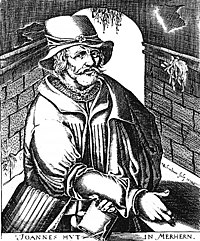Hans Hut

| Part of a series on |
| Anabaptism |
|---|
 |
|
|
Hans Hut (c. 1490 – 6 December 1527) was a very active
Life
Hut was born in Haina near Römhild, South Thuringia, and became a travelling bookseller. Hut was for some years sacristan in Bibra to the knight Hans von Bibra (the brother of Bishop Lorenz von Bibra). He early came under the influence of Thomas Müntzer and, refusing to have his child baptized, was driven from the community in 1524.[1] He took part in the decisive battle of Thuringia during the German Peasants' War on 15 May 1525 at Bad Frankenhausen. About a week later at Bibra, Hut preached "subjects should murder all the authorities, for the opportune time has arrived." In his later years Hut distanced himself from Müntzer, saying that he (himself) "had clearly erred" and that he "had not understood him (Müntzer)."[2] After the battle he managed to flee and traveled throughout the region.
On
His mission activity extended from the Thuringian-French border in the north to
In May 1527,
Hut is the author of Ausbund no. 8, “O Thou Almighty Lord and God” (O Allmächtiger Herr Gott), which is still in the hymnal used today by North American Amish congregations.[6]
Works
- Von dem geheimnis der tauf, baide des zaichens und des Wesens, ein anfang eines rechten wahrhaftigen christlichen Lebens (1527)
- Ein christlicher Underricht, wie göttliche geschrift vergleicht und geurtailt solle werden. Aus kraft des heiligen geists und zeuknus der dreitail christlichen Glaubens sambt iren verstand (1527)
References
- ^ Albert Henry Newman . A manual of Church history . American Baptist Publication Society, 1903, page 161
- ^ Williams, George Huntston. The Radical Reformation, 3rd Edition. Truman State Univ Press, 2000. p. 168
- ^ Charles Steven Seymour. A Theodicy of Hell. Springer. 2000.
- ^ Morwenna Ludlow, The Journal of Ecclesiastical History (2004), Cambridge University Press – "Why Was Hans Denck Thought to Be a Universalist?
- S2CID 162438424.
- ^ "O Allmächtiger Herr Gott". Archived from the original on 2008-12-24. Retrieved 2009-04-08.
Further reading
- Gottfried Sebaß: Müntzers Erbe. Werk, Leben und Theologie des Hans Hut. Gütersloh 2002.
- Werner O. Packull: Mysticism and the Early South German - Austrian Anabaptist Movement. Scottdale 1977.
- Hans-Jürgen Goertz: Die Täufer. Geschichte und Deutung. München 1988, 2. Auflage
- Gottfried Sebaß: Das Zeichen der Erwählten : zum Verständnis der Taufe bei Hans Hut- in: Umstrittenes Täufertum : 1525 - 1975; neue Forschungen(Hrsg. Hans-Jürgen Goertz), 1975, S. 138 - 164.
External links
- Hans Hut in Global Anabaptist Mennonite Encyclopedia Online (GAMEO)
- Complete text Ausbund no. 8 (PDF) [1][permanent dead link]
- Ausbund no. 8, O Allmächtiger Herr Gott sung in German [2]
- Ausbund no. 8, “O Thou Almighty Lord and God” (O Allmächtiger Herr Gott) sung in English [3]
